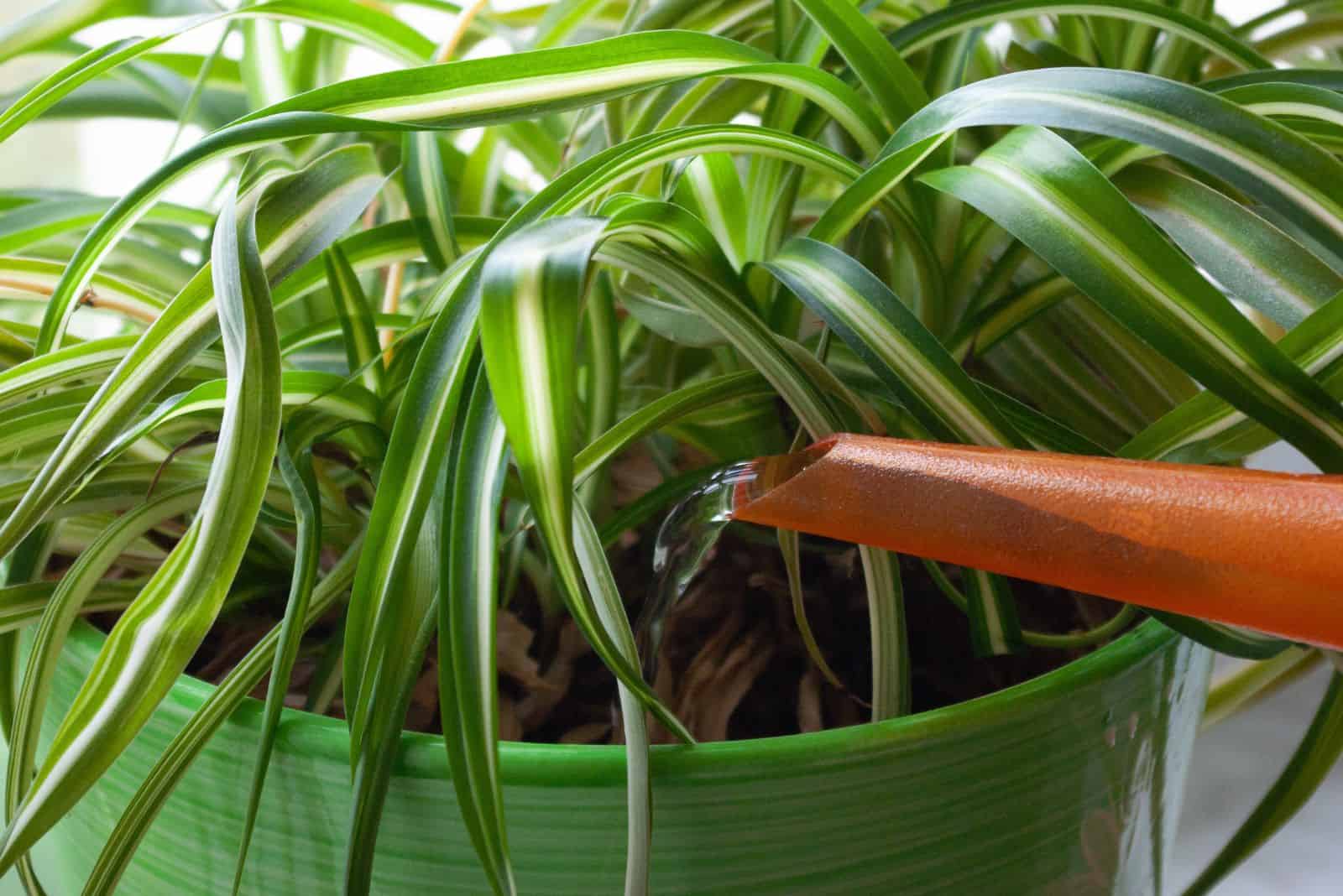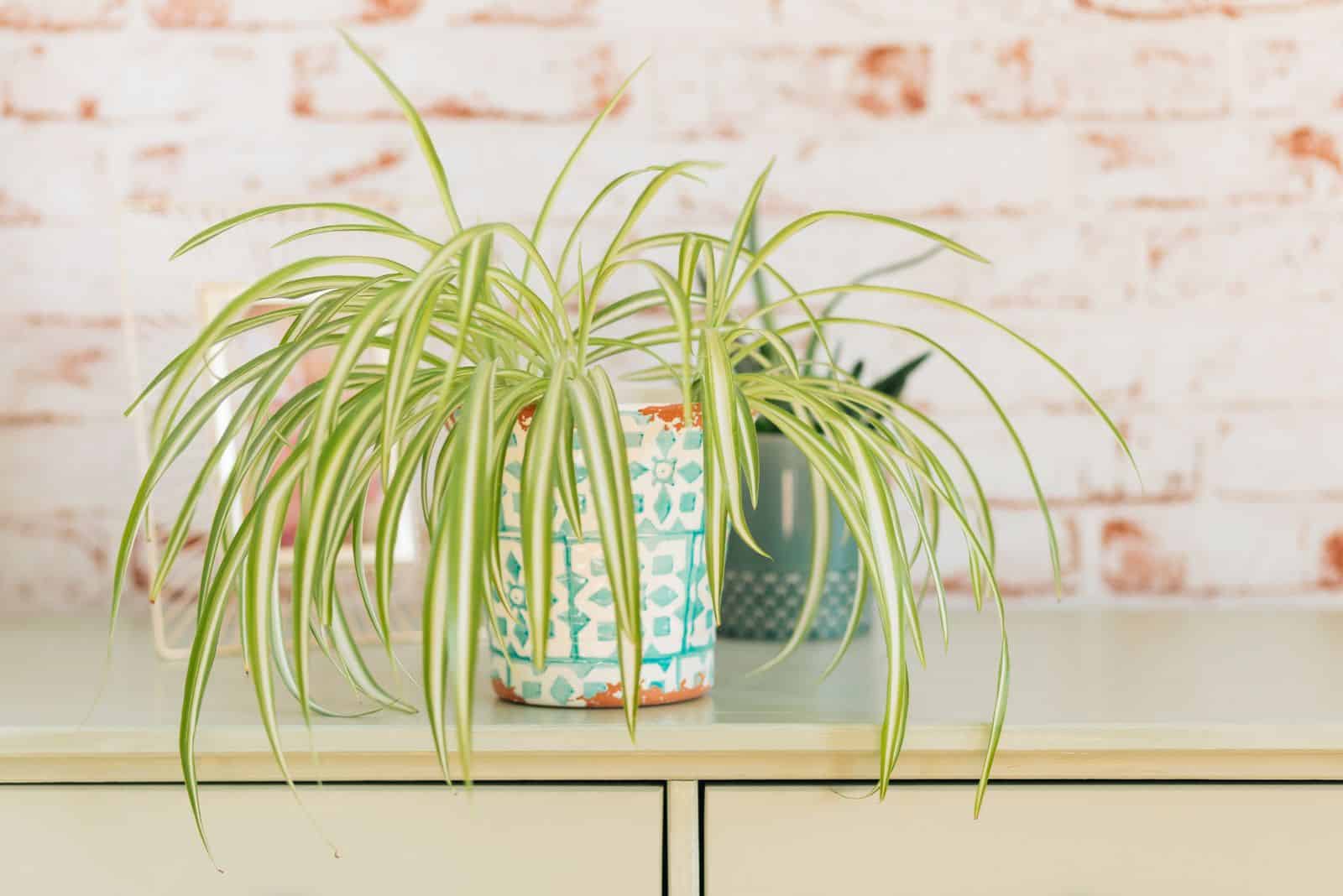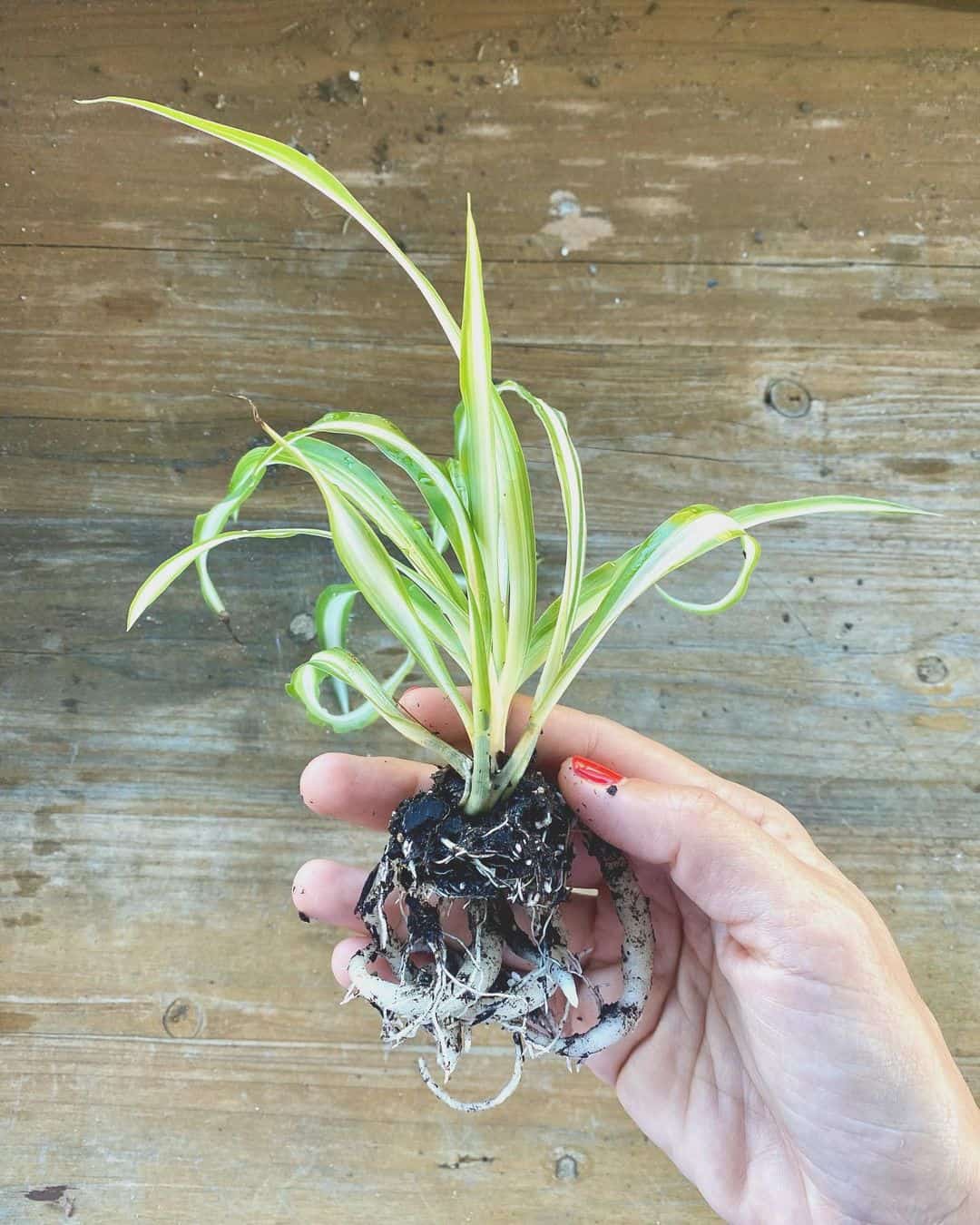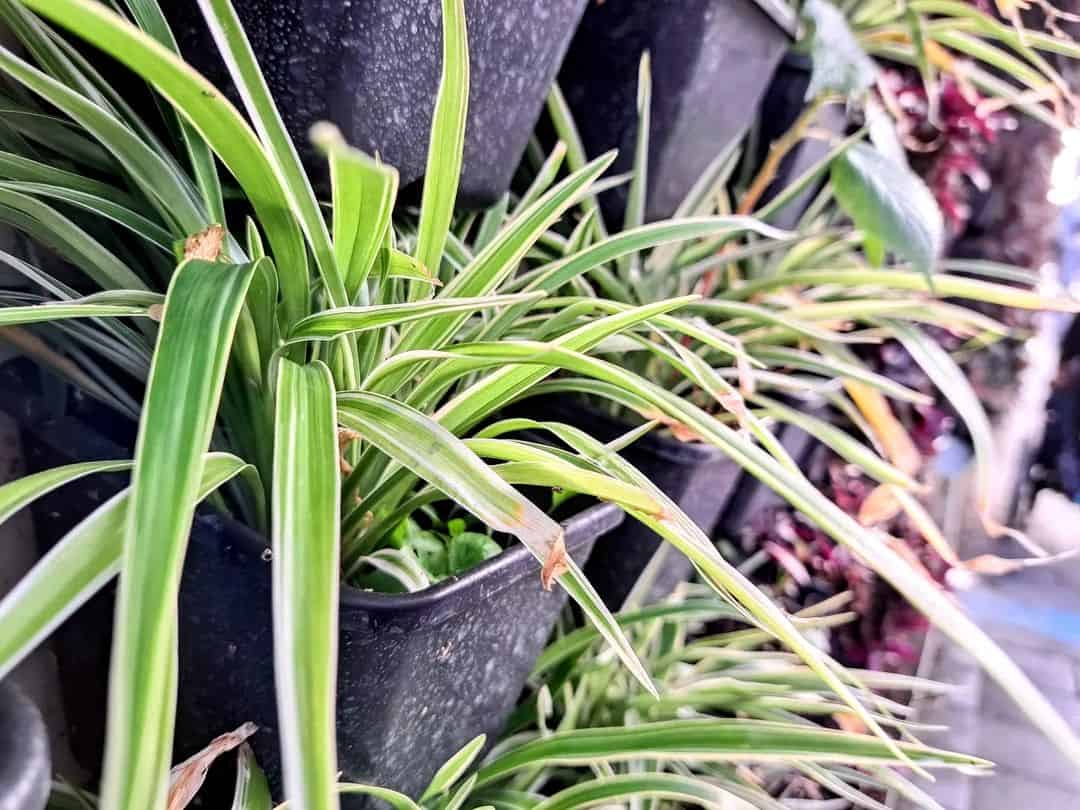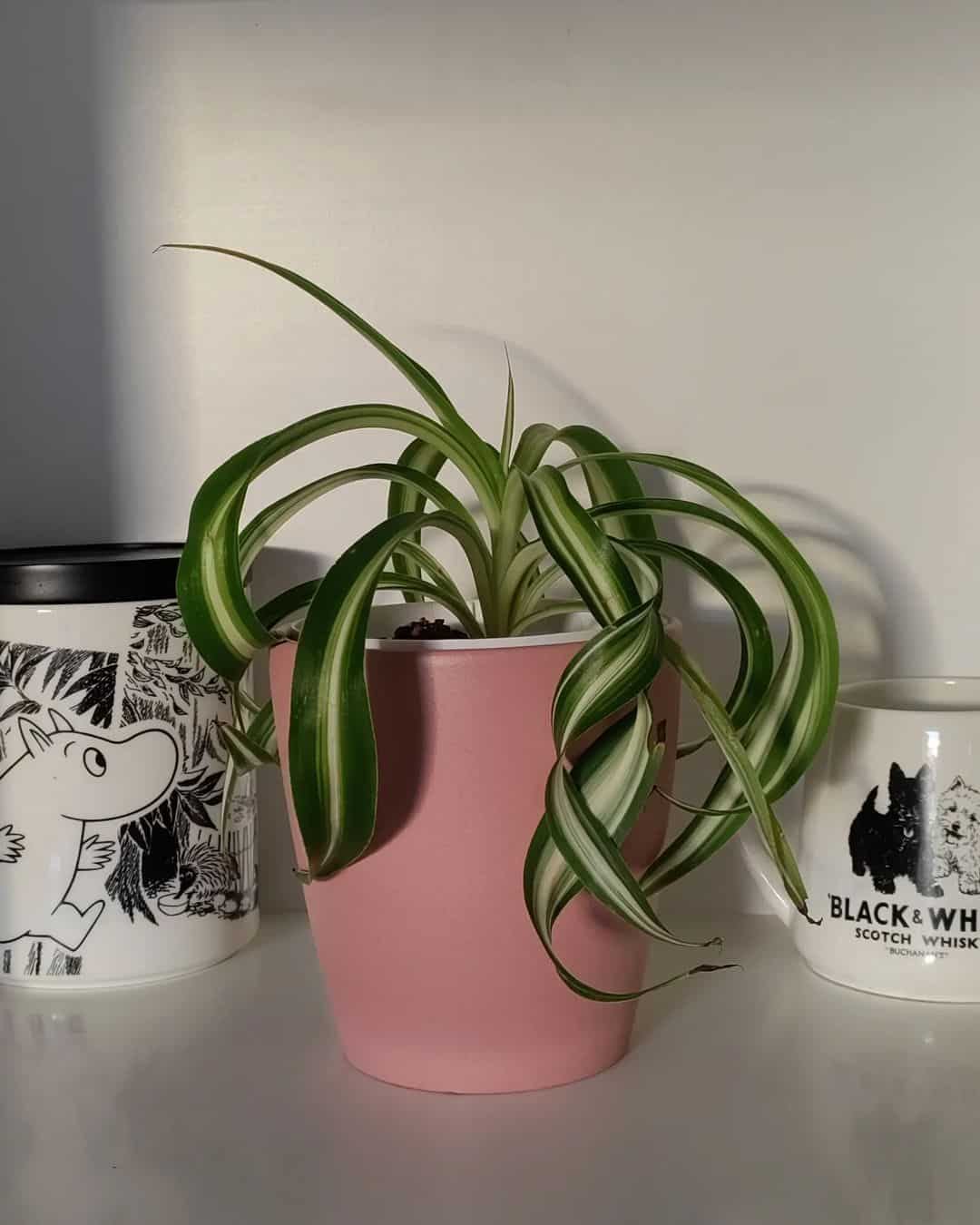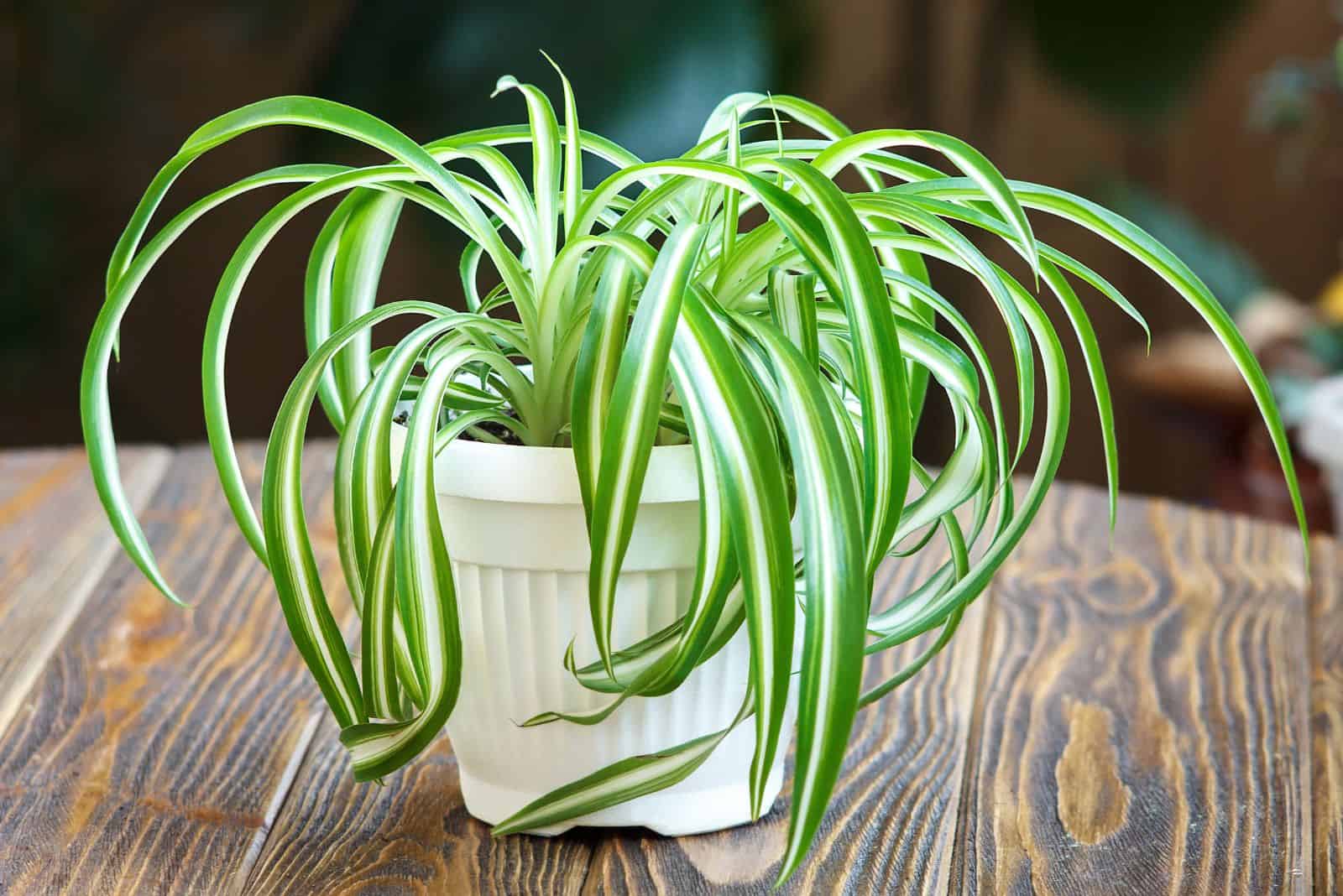The airplane plant, also known as the spider plant, is a popular houseplant famous for its pups that look like tiny arachnids, hence the name.
One of the things that growers love about this species is that it can tolerate low-light levels quite well.
It’s easy to care for, which makes it perfect for beginners and displaying in your favorite hanging basket.
Even though it’s easy to care for, there’s still a possibility of having to deal with some bumps in the road, such as pest infestations, disease infections, leaf discoloration, and thin appearance.
But don’t worry; we’ll discuss all these potential issues and look at some ways of treating and preventing them so that you can keep your spider plant healthy.
And since these species are so hard to resist, we’ll also present some popular airplane plant varieties you might want to incorporate into your indoor garden.
As for now, let’s learn the basic info about spider plants:
[table id=642 /]
Airplane Plant Care Guide
What’s great about airplane plants is that they don’t require too much care; plant them in a well-draining potting mix, keep them in a warm spot and a bright light location, and water them once the top part of their substrate begins to dry, and they’ll be fine.
Of course, we do have to pay attention to their other requirements that aren’t as immediate as these ones, such as pruning, repotting, etc.
We’ll discuss everything you need to know about nurturing your ribbon plant, and show you how to multiply it so you can turn your home into an indoor jungle.
Let’s get started!
Light Requirements
Spider plant light requirements are straightforward; expose your indoor friend to bright indirect light and it will thrive!
If you keep it in direct sunlight, its foliage might get burned, which will harm its appearance and overall health.
Instead, place your airplane plant on a south or east-facing windowsill where the direct sun in the morning and afternoon isn’t as harsh. What’s more, this plant gets indirect sunlight in this location, which tends to all its needs.
You can even expose your green buddy to low-light conditions, but if it’s too shady, it won’t grow as fast as it can.
Also, if you notice pale leaves on your airplane plant, you should move it to a location with moderate or bright indirect light so it can produce chlorophyll properly and photosynthesize.
Water And Humidity
When it comes to watering spider plants, the best gardening tip we can give you is to do so whenever the top portion of the potting mix is dry.
Generally speaking, it would be about once a week during their growing season, but if you live in a particularly hot and dry region, you might need to irrigate them more frequently.
And during dormancy (which lasts from late fall to late winter or early spring), you should only water your airplane plant every other week or so when you notice that the topsoil is dry.
You should also be mindful of the type of water you use. For instance, rainwater and distilled water are perfect because they don’t contain any surplus of nutrients that can harm your plant.
Tap water, on the other hand, can have too much chlorine, so you should pour it into a glass or a watering can and leave it in the open so that the mineral can evaporate before using it.
Furthermore, when irrigating your spider plants, always make sure to keep pouring until you notice the excess water draining out through the holes in the bottom of the planter.
Humidity
The ribbon plant is native to tropical climates, so it thrives in higher humidity levels.
Therefore, you should ensure that your average indoor air moisture levels are between 50-60% to keep it happy.
Household humidity is usually around 30-40%, but you can increase it using a humidifier or by misting your spider ivy from time to time.
Another great option is to move it to a kitchen or a bathroom. These rooms are usually more humid than the rest of your home and can meet your spider plant’s requirements.
(Don’t worry if your bathroom isn’t the brightest room in the house; these green airplanes can tolerate lower light levels.)
Temperature
When you have a purple spider plant or any other type of airplane plant, you need to ensure that you meet their temperature requirements in order for them to develop healthily.
Therefore, you should strive to keep them in temperatures between 70-90°F.
Since the spider plant is cold hardy in USDA zone 9, it can tolerate temperatures down to 35°F, although you won’t see much growth at this point.
Therefore, keep them in conditions no lower than 65°F, and they will thrive.
Another thing you should be mindful of is not to expose your spider ivy plant to sudden temperature fluctuations, and avoiding areas near drafty windows, doors, AC vents, heaters, etc. can help you with this.
Soil And Fertilizer
The best potting soil for spider plants is loose, fertile, and well-draining. You can get such mediums in your local garden center – just look out for peat moss, coconut coir, and similar organic materials.
And if you want to create your own medium, you can mix 2 parts high-quality potting soil with 2 parts perlite and bark at a ratio of 1:1.
You can also use compost or add some vermicompost to the formula above.
Finally, make sure that the growing medium has a pH level between 6.0-6.5, which will provide optimal conditions for nutrient and moisture absorption.
Fertilizer
The best fertilizer for spider plants is any houseplant plant food you can find.
If you prefer using water-soluble fertilizers, you can apply them 1-2 times per month. If this is too much for you because you tend to forget the feeding schedule (as we often do), then you can use slow-release fertilizers every 3-6 months.
But whichever you use, remember to feed your plants only during their growing season since that’s when they need the boost.
You shouldn’t fertilize newly propagated or repotted plants, although if you’ve repotted the plants in your own blend that doesn’t contain added plant food, then you can feed them at once.
If you use ready-made potting soils, read the label carefully. Many of them contain fertilizers that last for up to six months, so you don’t need to feed them additionally.
In fact, if you fertilize your plants too often or too soon, you risk overfertilization and root burn.
Repotting
Spider plants are avid growers, so you’ll know it is the time to repot them once you can seed the roots protruding from the drainage holes.
Rootbound plants cannot absorb moisture and nutrients properly, which is why you should repot your airplane plant every 1-2 years.
The best time to move your spider ivy to a new planter is in spring because that’s when it actively grows. Of course, you can repot it in summer, just not in winter because it would be too stressed and unable to adjust to its new home.
When repotting, you can leave the growing medium around the roots, but if your plant is too rootbound, you should separate them a bit before planting to ensure it can uptake water and minerals.
Choose a pot 1-2 sizes bigger than the previous one, place some substrate in the bottom, plant your ribbon plant in it, and fill everything with more potting mix.
Afterwards, water your spider ivy thoroughly and take it back to its usual position.
Pro tip: If your plant’s roots are dark or and mushy, you should remove them before potting.
Pruning
Since spider plants have a fast growth rate, you should prune them whenever they get too big for their environment.
Also, the Bonnie curly spider plant care guide teaches us to trim its foliage to keep it healthy, and the same goes for every airplane plant.
Therefore, if you notice some discolored leaves, you should prune them as soon as you see them to make room for new growth.
When trimming, try and remove the leaves as close to the base as possible.
If you prune your ribbon plant to control its size, you should do it in spring or summer so that it can recover and put on some new growth before dormancy.
If, on the other hand, you simply want to remove old, diseased, dying, and discolored foliage, you can do so whenever you need to.
Propagation
The most common (and the easiest) way to multiply the spider plant is using pups or plantlets. These offshoots appear on the parent plant and can even develop a root system while still attached to their mother.
Another way to reproduce an airplane plant is by dividing them, although they have to be quite large in order to do this.
We’ll discuss both methods in the following sections, and you can choose the one that fits your needs best.
(For instance, if your plant has plenty of spiderettes you don’t want to discard, you can plant them. And if your ribbon plant is too large, you can divide it so that you can control its growth better.)
Propagation By Spider Plant Babies
Step 1. Let the pups reach a size of at least 2 inches before cutting them.
Step 2. Remove the plantlets from the parent plant with sharp and sterilized scissors. Ensure they have about an inch of stem with them. Then, you can remove the entire shoot from the parent plant.
Step 3. Plant the spider baby plants in a well-draining growing medium, water it, and ensure a high humidity environment.
Step 4. Place the spiderette in a location with indirect sunlight and keep the substrate consistently moist.
Pro tip: You can propagate the pups in water; just make sure to change it whenever it gets foggy. You can also plant the spiderettes without cutting them from the mother plant at first. Once they establish a root system, you can cut the cord connecting them.
Here are some quick tips for multiplying an airplane plant from its pups:
Propagation By Division
If your spider ivy plant is too large for your home, you can simply divide it when repotting, which will reduce its size and give you a brand new plant to enjoy (or to give to your neighbors).
Step 1. Take the plant out of its pot, loosen the soil around the root ball, and remove it completely.
Step 2. Gently start separating the shoots with individual root systems. If you cannot do it by hand because the roots are all entangled, you can use pruners to cut them. Try to be as non-invasive as possible.
Step 3. Plant your new airplane plants into separate containers, water them thoroughly, and move them to a location with bright indirect light.
And if you need more guidelines, here is an excellent video for dividing the ribbon plant:
Common Issues With Spider Plants
When you look at your airplane plant and see that it isn’t doing well, you’ll likely wonder why your spider plant is dying.
Well, the only reason is a lack of adequate care, but don’t worry; we’ve all been there, especially when we have other things going on in our lives.
You might notice some pests crawling all over your spider ivy, diseases starting to take hold, leaf discoloration, and an overall thin appearance of your plant.
We’ll discuss the potential causes of these issues and present some possible solutions so that you can nurture your ribbon plant back to health.
Pests
The usual insects we find lurking in our spider plants are spider mites, mealybugs, and aphids.
These bugs will infest your indoor buddy if you overwater it or don’t care for it properly.
Luckily, you can easily deal with infestations by spraying some neem oil or insecticidal soaps on the bugs.
Diseases
If you overwater your ribbon plant, it will lead to root rot – especially if you do it constantly.
Luckily, these members of the floral kingdom aren’t that sensitive to root rot because of their tuberous roots that can survive a lot of moisture.
However, you should still repair the damage by removing the diseased roots and repotting your plant in a new potting soil and container.
If you’re not sure whether your plant has root rot, just look for the signs. The most common symptoms of this disease include yellow discoloration, stunted growth, wilting, and a foul smell spreading from your plant.
Thin Plant
If you have a thin airplane plant, there are a couple of things you can change in your plant care routine to make it lusher.
To make a spider plant bushier, prune it during its growing season so that it can push out new growth. (Pay special attention to discolored and diseased leaves.)
You should also keep the spider ivy away from direct sunlight since it can burn its foliage. Instead, place it in an indirect light to encourage more new growth.
Make sure to water this plant whenever the top few inches of the substrate dry out, and keep it in higher humidity.
If this still doesn’t make it bushy enough, you can always propagate some plantlets and place them in the same pot, which will give it a thicker appearance.
Also, rootbound plants won’t be able to uptake water and nutrients properly, so repot them every 1-2 years.
You should also feed your airplane plant regularly to ensure a steady supply of the essential minerals it needs for optimal growth.
Leaf Discolorations
Leaf discolorations are usually caused by inadequate light levels. For instance, yellow and pale leaves are a sign that your ribbon plant doesn’t get enough sun, so you should gradually move it to a brighter location.
Lack of nitrogen can also lead to yellowing of the foliage, so make sure to feed your airplane plant regularly.
Finally, your spider plant may develop brown leaf tips in low humidity levels, when it doesn’t get enough water, or when you expose it to too much direct sunlight.
As you can see, there are a couple of different causes for leaf discolorations, which is why you should first eliminate some causes before treating your plant.
Popular Airplane Plant Types
There are many different spider plant varieties out there, with reversed variegation, purple colors, dark green leaves, small white flowers, and even curly foliage. Here are just a few of the most common ones:
Chlorophytum comosum ‘Vittatum’ – This species is also known as the variegated spider plant, and is characterized by a middle white stripe framed with green streaks.
Chlorophytum comosum ‘Bonnie’ – This beautiful cultivar looks almost the same as the abovementioned one, with one little adjustment – its leaves are curly.
Chlorophytum viridescens ‘Hawaiian’ – Notice how this species has a different name from the other two? Well, it also looks rather different. When young, it has a pale middle line framed with green, but as it grows older, it gets purely dark green leaves.
Chlorophytum comosum – We use this name for many airplane plants out there, but in this context we refer to the purple spider plant. Its unique variegation consists of green insides and purple margins.
There are many other species and varieties of the ribbon plant you can grow. For instance, some resemble the cultivars ‘Bonnie’ and ‘Vittatum’, but with reversed variegations, some have broader leaves, others have thin green margins, and wide creamy center, etc.
You just have to find the right one for you, and since there are so many of them, it is both a blessing and a curse.
FAQ
Are airplane plants poisonous?
No, airplane plants are not toxic to humans or pets, so you can place them wherever you want.
Some claim that they have hallucinogenic effect on cats, but there’s no scientific research to back it up.
It’s more likely that your pet loves it because of its playful appearance and interesting plantlets, and not the potential trip it might get from it!
What is the lifespan of spider plants?
Spider plants are perennial species and can live up to 10 years in good growing conditions.
But if you learn how to propagate them, you can have these plants with you forever.
What are the benefits of airplane plants?
One of the main spider plant benefits is its air-purifying ability. According to NASA research, this green bundle of joy can remove formaldehyde from your home.
However, it would take hundreds of plants to clean the indoor air completely from this substance, but having a couple of them around certainly won’t hurt.
Final Thoughts
The Airplane plant, more commonly known as the spider plant, is one of the best houseplants you’ll come across.
It is incredibly easy to grow, and all you need to do is keep it at room temperature, expose it to a bit of indirect light, plant it in a fertile and well-draining potting soil, and water it once the top part of the mix begins to dry out.
And if you want to create perfect growing conditions for it, you can fertilize it once a month with liquid fertilizer (or 2-3 times a year with a slow-release one), increase the indoor humidity to about 50-60%, and repot it every so often.
We included some tips for propagating it successfully, so that you can have a never-ending supply of spidery ivies in your home.
Furthermore, if you don’t care for it properly, you will eventually have to deal with issues such as pests, diseases, leaf discolorations, and thin plants. Therefore, we included some tips to help you cross this bridge when you come to it.
For the end, we included a couple of gorgeous spider plant varieties to get you started on an indoor jungle.
Until next time!

